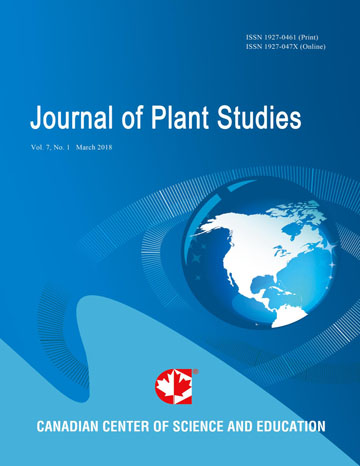Antifungal Effects of Paraquat and Glyphosate on Rhizoctonia solani (Kühn) in Potato in vitro Condition
- José L. Arispe Vázquez
- Abiel Sánchez Arizpe
- Ma E. Galindo Cepeda
- Cristina Trejo Ramos
Abstract
Potato is one of the main crops worldwide. It this research, antifungal activity in vitro of paraquat and glyphosate were evaluated for Rhizoctonia solani control. R. solani was identified from potato tubers collected out from at open markets in Saltillo, Coahuila, Mexico. Two types of herbicides were applied: paraquat and glyphosate, at four different dosage treatments of: 10, 100, 1 000 and 10 000 μL. One 5 mm diameter PDA disc with R. solani mycelium was placed at the center of the Petri dish, with a radial registry fungal every 24 h for 192 h. Pathogen was identified by morphological criteria and the data was evaluated randomly with a factorial arrangement, on which, herbicides represented factor A and dosage treatments were represented by factor B. Thus experimental design had two levels for factor A and five levels for factor B with six replications. The results were analyzed by the SAS version 9.1 statistical program, the mean separation with the Tukey test (p=0.05). Glyphosate achieved inhibition of R. solani by 35.5882% and paraquat up to 80.0399%. Results reveal the importance of the need for more studies of these herbicides as fungicides. High concentrations of paraquat (10 000 μL) inhibits R. solani, and glyphosate does not affect R. solani mycelium development at low dosages (10 and 100 μL) and inhibits it at higher doses (10 000 μL).
- Full Text:
 PDF
PDF
- DOI:10.5539/jps.v10n1p16
Index
- AGRICOLA
- CAB Abstracts
- CABI
- CAS (American Chemical Society)
- CNKI Scholar
- Elektronische Zeitschriftenbibliothek (EZB)
- Excellence in Research for Australia (ERA)
- Google Scholar
- JournalTOCs
- Mendeley
- Open policy finder
- Scilit
- Standard Periodical Directory
- Technische Informationsbibliothek (TIB)
- WorldCat
Contact
- Joan LeeEditorial Assistant
- jps@ccsenet.org
